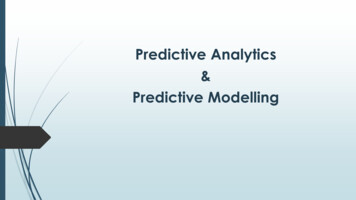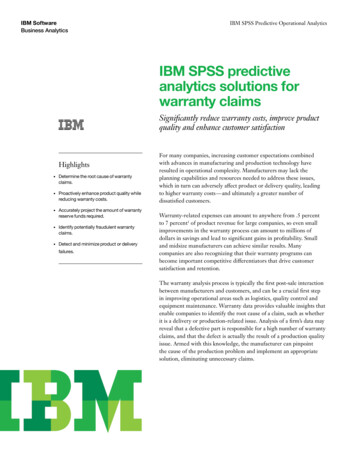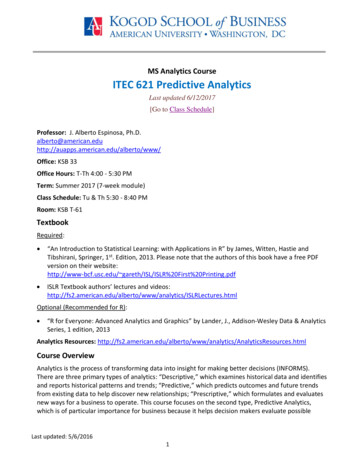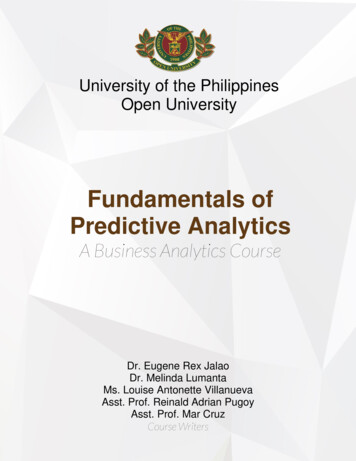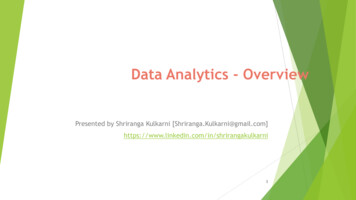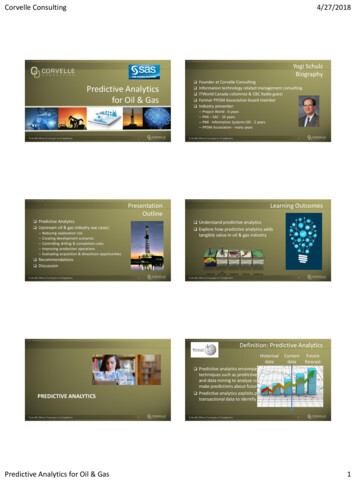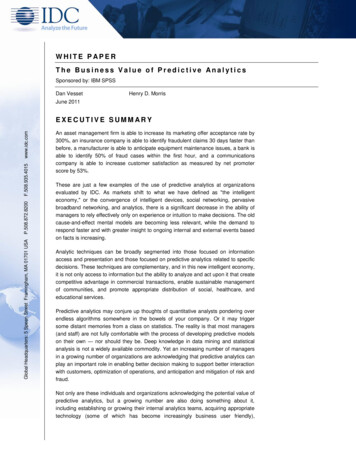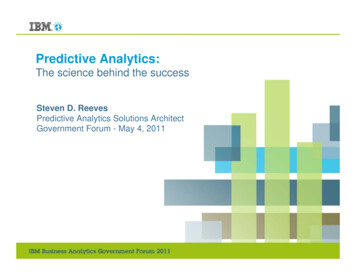
Transcription
Predictive Analytics:The science behind the successSteven D. ReevesPredictive Analytics Solutions ArchitectGovernment Forum - May 4, 2011
Agenda Traditional statistics and data mining Questions data mining can answer Data mining: Three classes of algorithms– Prediction– Association– Clustering Supervised vs. unsupervised learning– Supervised: Prediction and classification– Unsupervised: Clustering, Association and Anomaly Detection Text Analysis Use Cases
Data mining and statistical analysis Statistical analysis––––Confirm hypothesesMore data requirementsMore assumptionsGeneral populationpredictions– Cumulative resultsUser-driven Data mining––––––Generate hypothesesMore exploratoryLess data prepFewer assumptionsIndividual predictionsResults-orientedData-driven
Statistics – use case examples Used often in experimental design, clinical trials andsurvey research with complex sampling designs– N.O.R.C. and Gallup use extensive inferential statisticsaccurately representing survey data on how peoplethink and feel about the world today.– NIH uses inferential statistics to analyze experimentaldata to quantify significant differences in treatmentsand interventions.– CDC – extensive epidemiological studies requireinferential statistics Used to create data when you don’t have it.– Sample size– Effect size– Validity of results4
Data mining Data mining: A branch of computer science, isthe process of extracting patterns from largedata sets by combining methods from statisticsand artificial intelligence with databasemanagement. (Wikipedia)– Business understanding– Data understanding– Data Preparation– Modeling– Evaluation– Model deployment Predictive analytics: Informs and directsdecision-making by applying a combination ofadvanced analytics and decision optimization todata, with the objective of improving businessprocesses to meet specific organizational goals.5
Data mining question types Market segmentation – identify common characteristics of constituents who aresimilar (e.g., buy the same products, use the same services) Churn - predict who’s leaving Fraud/anomaly detection – discover and predict what transactions are fraudulent Direct marketing- predict who’s likely to respond Interactive marketing – predict what will make people respond differently at point ofinteraction Market basket analysis – identify products or services purchased or utilized together Trend analysis – look at differences through time and or across groups– Have service utilization rates gone up or down? Sequence analysis – describe the most typical series of events leading to a consequent– What parts typically fail prior to an expensive servicing?– What requests are made of IT Support before catastrophic network failure?
Data mining Three classes of data mining algorithms Supervised vs. unsupervised ComplementaryWhat events occurtogether? Given aseries of actions;what action is likelyto occur next?Cluster“Differences”Group cases thatexhibit nships”Associate“patterns”Predict who is likelyto exhibit specificbehavior in the future.7
What is Unsupervised Learning? A data mining technique when we donot know the output or outputs Can be thought of as finding ‘useful’patterns above and beyond noise or “fishing” for information Looks for natural groupings in the data Can be used for data reduction,preparation and simplification
Unsupervised Learning: Questions Market segmentation – identify common characteristics of constituents who are similar(e.g., buy the same products, use the same services) Churn - predict who’s leaving Fraud/anomaly detection – discover and predict whattransactions are fraudulent Direct marketing- predict who’s likely to respond Interactive marketing – predict what will make peoplerespond differently at point of interaction Market basket analysis – identify products or services purchased or utilized together Trend analysis – look at differences through time and or across groups– Have service utilization rates gone up or down? Sequence analysis – describe the most typical series of events leading to a consequent– What parts typically fail prior to an expensive servicing?– What requests are made of IT Support before catastrophic network failure?9
What is Supervised Learning? A technique when we know theoutput or outputs We will “supervise” the algorithmand tell it what we want to predict Often uses the resultsof unsupervised learningas predictors Used to predict usually anoutcome or a quantity
Supervised Learning: Questions Market segmentation – identify common characteristics of constituents who are similar(e.g., buy the same products, use the same services) Churn - predict who’s leaving Fraud/anomaly detection – discover and predict which transactions are fraudulent Direct marketing- predict who’s likely to respond Interactive marketing – predict what will make people respond differently at point ofinteraction Market basket analysis – identify products or services purchased or utilized together Trend analysis – look at differences through time and or across groups– Have service utilization rates gone up or down? Sequence analysis – describe the most typical series of events leading to a consequent– What parts typically fail prior to an expensive servicing?– What requests are made of IT Support before catastrophic network failure?11
Text analyticsThe purpose of Text Extraction is to capture key concepts from a collection oftext (Corpus), and use this information to help uncover hidden themes, trends,and to identify relationships between conceptsThrough its history, IBM has been a leader of this evolution. And over the past decade, IBM has pioneered new forms of social engagement—most importantly, through direct engagement of its technology and employees’ expertise to benefit society. Thus, it is not an accident thatCorporate Service Corps (CSC) was modeled on the Peace Corps. “It’s not just philanthropy,” says Stanley Litow, IBM’s vice president ofcorporate citizenship and Hello affairs. “It’s leadership development and business development, and it helps build economic development in theemerging world.”The CSC creates value in three dimensions. For the My name is Steven Reeves, the result is tangible IT and business improvements, and ablueprint for progress. For the IBMers, working with colleagues, local citizens and officials from around the world, it’s an opportunity to hone theircultural and marketplace literacy. For many of them, it’s also a life-changing experience, inspiring them to deepen their societal engagement andeven career direction. For IBM, the company gains experienced leaders, inspired employees, insights into new markets.The idea for the program arose from IBM’s strategy to become a globally integrated enterprise. Like many multinational corporations, IBM used toprovide I am a overseas assignments for small numbers of executives, typically one- or two-year assignments. But that approach was not onlyexpensive, its reach was limited and the skills it taught were traditional. The CSC idea is to instill truly global perspectives and leadership skills forless-structured, diverse business environments and cultures in a large number of people. An assessment of the program Predictive Analyticsconducted by Christopher Marquis, a professor at Harvard Business School, found that it works. “These kinds of skills are increasingly important.As the world gets flatter the ability to manage across all of these cultural differences is going to be much more important,” says Marquis.The CSC portfolio has broadened over the years. For instance, in 2010, IBM Solutions Architect created a variant of the program, called theCorporate Service Corps Executive (CSCE), program to deploy more senior executives on more advanced engagements, such as the one inKatowice. The teams work with high-level city officials on critical economic development projects, with the aim of making metropolitan areas intoworld-class smarter IBM SPPS cities. Initial projects included Ho Chi Minh City, Rio de Janeiro and Chengdu, China. Also in 2010, IBM launchedthe Smarter Cities Challenge. Over the next three years, it plans on dispatching teams of CSCE-level IBMers to 100 cities—half in emergingmarkets and half in developed ones.The CSC concept is now spreading to other companies. Industrial giants Dow Corning, Novartis and FedEx are launching similar programs, andthe US Agency for International Development in 2010 began collaborating with IBM to help smaller companies get involved. Just as the PeaceCorps has inspired generations of Americans since it was launched in 196012
Text analyticsThe purpose of Text Extraction is to capture key concepts from a collection oftext (Corpus), and use this information to help uncover hidden themes, trends,and to identify relationships between conceptsThrough its history, IBM has been a leader of this evolution. And over the past decade, IBM has pioneered new forms of social engagement—most importantly, through direct engagement of its technology and employees’ expertise to benefit society. Thus, it is not an accident thatCorporate Service Corps (CSC) was modeled on the Peace Corps. “It’s not just philanthropy,” says Stanley Litow, IBM’s vice president ofcorporate citizenship andthe emerging world.”Hello affairs. “It’s leadership development and business development, and it helps build economic development inMy name is Steven ReevesThe CSC creates value in three dimensions. For the, the result is tangible IT and businessimprovements, and a blueprint for progress. For the IBMers, working with colleagues, local citizens and officials from around the world, it’s anopportunity to hone their cultural and marketplace literacy. For many of them, it’s also a life-changing experience, inspiring them to deepen theirsocietal engagement and even career direction. For IBM, the company gains experienced leaders, inspired employees, insights into new markets.The idea for the program arose from IBM’s strategy to become a globally integrated enterprise. Like many multinational corporations, IBM used toI am aprovideoverseas assignments for small numbers of executives, typically one- or two-year assignments. But that approach was notonly expensive, its reach was limited and the skills it taught were traditional. The CSC idea is to instill truly global perspectives and leadershipskills for less-structured, diverse business environments and cultures in a large number of people. An assessment of the programPredictive Analytics conducted by Christopher Marquis, a professor at Harvard Business School, found that it works. “Thesekinds of skills are increasingly important. As the world gets flatter the ability to manage across all of these cultural differences is going to be muchmore important,” says Marquis.Solutions ArchitectThe CSC portfolio has broadened over the years. For instance, in 2010, IBMcreated a variant of theprogram, called the Corporate Service Corps Executive (CSCE), program to deploy more senior executives on more advanced engagements,such as the one in Katowice. The teams work with high-level city officials on critical economic development projects, with the aim of makingIBM SPPSmetropolitan areas into world-class smartercities. Initial projects included Ho Chi Minh City, Rio de Janeiro and Chengdu,China. Also in 2010, IBM launched the Smarter Cities Challenge. Over the next three years, it plans on dispatching teams of CSCE-level IBMersto 100 cities—half in emerging markets and half in developed ones.13Inc. 2009 SPSS13
Text miningText analytics: A method for extracting usable knowledge fromunstructured text data through identification ofcore concepts, sentiments and trends, and thenusing this knowledge to support decision making. Is not the same as SEARCH. Search enginesare a “top down” approach to finding informationin textual material. Discovers connections and relationships not withina single document but across a large collection or“corpus” of documents. May use algorithms to describe clusters of concepts, orassociations between certain concepts or named entities. Computational Linguistics – Natural Language Processing(NLP) – Morphology, Syntax, Semantics14
Data mining and text mining While both data mining and text mining aim at extracting patternsin data, data mining uses only structured data as input while textmining can also work with information stored in an unstructuredcollection of documents Before data mining tools can be used to find patterns in free textdata the information contained therein must first be convertedinto structured data called concepts, types and categories15
Extractor Component Workflow: DetailsInputInput orcing ExtractionExtractionExtractedExtracted conceptsconceptsTLATLA patternspatternsCategorizationCategorization16
Concepts – (Term)Concepts are the literal words or phrases extracted from the text data.Example: “The Cocker Spaniel ran fast.”Concepts can be sorted: Byalphabetic order Byfrequency: By Global frequency represents the number of times a concept (orone of its terms or synonyms) appears in the entire set ofdocuments or records Docs represents the proportion of documents or record whichcontain the selected concept (or one of its terms or synonyms).type17
TypesTypes are semantic groupings of concepts, stored in the form of typedictionaries. Types are different from categories: Theyare an attribute of concepts (or non-linguistic entities),given by the extractor engine during concept extraction Theyare created and maintained through dictionaries Theycan even serve to define a category (not the other way round)Default types are: Organization, Person, Product, Location, Date Concepts that are not found in any type dictionary but that areextracted from the text are automatically typed as: Unknown 18
CategoriesCategories - refers to a group of closely related ideas and patterns towhich documents and records are assigned through a scoring process.Categories allow to aggregate a large number of concepts under thesame field to facilitate further data miningEach category is defined by one or more descriptors.Descriptors are concepts, types, and patterns as well as conditionalrules that have been used to define a hington Nationals, Baltimore Orioles, NY Yankees .19
TLA: Patterns A Boolean query that is used to perform a match on a sentence of text.Example:– “The N1H1 Virus was reported in Seattle.”– “The customer was not happy with the service.”– “Jones traveled to Bern on 02/23/11.” A TLA pattern is a stipulated pattern of concepts.20
IBM SPSS Text MiningHuman capital management case study
Case Study: U.S. Army Reserve - OCAR Challenge – Reduce and determine reasons for reserve attrition Reserve soldiers have careers and responsibilities outside of theU.S. Army, making high attrition rates an ongoing challenge. Need to determine the characteristics that lead to attrition and thetypes and levels of incentives that can aid in retaining a soldier Solution – IBM SPSS Modeler SPSS Modeler used to classify soldiers at risk of attrition, including theanalysis of military occupational skills (MOS) in classifying attrition SPSS Modeler to create models for incentive planning. Benefits Predicted attrition using demographic data for army reservists. Created a predictive model to analyze why reservists leave and used thismodel for scoring the possibility for attrition of candidates on a weekly basis. Modeled the soldier incentive types and levels that would minimizecost and attrition.
Retention Modeling ProcessCurrentEmployees(Education, jobhistory, experience,demographics)Likelihood of SuccessCurrentDataIfExperience Info SystemsAnd Education UndergradAnd Years Working 5And Communication Skills 7Then Success Medium(35, 0.78)Likelihood to SeparateIfEducation Post GraduateAnd Years Working 7And used “travel” (sentiment NEGATIVE)And Commute 30minsThen Leave YES (94, 0.927)Identify characteristics ofemployee success andattrition / (dis)satisfactionSurvey Data(Attitudes, non workrelated factors)Retention Incentives1.2.3.4.5. Salary Increase ,prob 0.23Not applicableFlexible Schedule, prob 0.87PerformanceAward, prob 0.36Benefits,prob 0.54Payroll(Comp plans,salary)Managers reports onemployee satisfactionand performanceDataCollection
Retention Modeling ProcessCurrentEmployees(Education, jobhistory, experience,demographics)Likelihood of SuccessIfExperience Info SystemsAnd Education UndergradAnd Years Working 5And Communication Skills 7Then Success Medium(35, 0.78)Likelihood to SeparateIfEducation Post GraduateAnd Years Working 7And used “travel” (sentiment NEGATIVE)And Commute 30minsThen Leave YES (94, 0.927)Identify characteristics ofemployee success andattrition / (dis)satisfactionPayroll(Comp plans,salary)Predictive ModelingSurvey Data(Attitudes, non workrelated factors)Retention Incentives1.2.3.4.5. Salary Increase ,prob 0.23Not applicableFlexible Schedule, prob 0.87PerformanceAward, prob 0.36Benefits,prob 0.54Managers reports onemployee satisfactionand performance
Retention Modeling ProcessCurrentEmployees(Education, jobhistory, experience,demographics)Likelihood of SuccessIfExperience Info SystemsAnd Education UndergradAnd Years Working 5And Communication Skills 7Then Success Medium(35, 0.78)Likelihood to SeparateIfEducation Post GraduateAnd Years Working 7And used “travel” (sentiment NEGATIVE)And Commute 30minsThen Leave YES (94, 0.927)Identify characteristics ofemployee success andattrition/ (dis)satisfactionTextMiningSurvey Data(Attitudes, non workrelated factors)Retention Incentives1.2.3.4.5. Salary Increase ,prob 0.23Not applicableFlexible Schedule, prob 0.87PerformanceAward, prob 0.36Benefits,prob 0.54Payroll(Comp plans,salary)Managers reports onemployee satisfactionand performance
Retention Modeling ProcessCurrentEmployees(Education, jobhistory, experience,demographics)Batch ScoringLikelihood of SuccessIfExperience Info SystemsAnd Education UndergradAnd Years Working 5And Communication Skills 7Then Success Medium(35, 0.78)Likelihood to SeparateIfEducation Post GraduateAnd Years Working 7And used “travel” (sentiment NEGATIVE)And Commute 30minsThen Leave YES (94, 0.927)Identify characteristics ofemployee success andattrition / (dis)satisfactionSurvey Data(Attitudes, non workrelated factors)Retention Incentives1.2.3.4.5. Salary Increase ,prob 0.23Not applicableFlexible Schedule, prob 0.87PerformanceAward, prob 0.36Benefits,prob 0.54Payroll(Comp plans,salary)Managers reports onemployee satisfactionand performance
Retention Modeling ProcessCurrentEmployees(Education, jobhistory, experience,demographics)Real-timeScoringLikelihood of SuccessIfExperience Info SystemsAnd Education UndergradAnd Years Working 5And Communication Skills 7Then Success Medium(35, 0.78)Likelihood to SeparateIfEducation Post GraduateAnd Years Working 7And used “travel” (sentiment NEGATIVE)And Commute 30minsThen Leave YES (94, 0.927)Identify characteristics ofemployee success andattrition / (dis)satisfactionSurvey Data(Attitudes, non workrelated factors)Retention Incentives1.2.3.4.5. Salary Increase ,prob 0.23Not applicableFlexible Schedule, prob 0.87PerformanceAward, prob 0.36Benefits,prob 0.54Payroll(Comp plans,salary)Managers reports onemployee satisfactionand performance
Retention Modeling ProcessCurrentEmployees(Education, jobhistory, experience,demographics)Likelihood of SuccessIfExperience Info SystemsAnd Education UndergradAnd Years Working 5And Communication Skills 7Then Success Medium(35, 0.78)Likelihood to SeparateIfEducation Post GraduateAnd Years Working 7And used “travel” (sentiment NEGATIVE)And Commute 30minsThen Leave YES (94, 0.927)Identify characteristics ofemployee success andattrition / (dis)satisfactionPayroll(Comp plans,salary)Decision OptimizationSurvey Data(Attitudes, non workrelated factors)Retention Incentives1.2.3.4.5. Salary Increase ,prob 0.23Not applicableFlexible Schedule, prob 0.87PerformanceAward, prob 0.36Benefits,prob 0.54Managers reports onemployee satisfactionand performance
FAA safety reports
Federal Aviation Authority (FAA)Understanding aviation accident outcomesBackground FAA requires written aviation safety reports submittedResultsfor each aviation incident relating to personal injury,aircraft malfunctions and accidents. The FAA is responsible for analyzing thousands ofaviation accident or incident reportsBusiness goals Needed a way to use accident report data to improvethe understanding of accidents resulting in ‘SevereInjuries’ Merge accident report data with other known factorsrelating to the incident such as Geography, Weather,Pilot Experience, and Aircraft TypeSolution Create a custom FAA Resource based on aviationterminology and existing Thesaurus Added Text mining to Data Mining Workbench Imported FAA Thesaurus intoText Mining Workbench Concepts and Categoriesextracted from AccidentReports were 7 of top 13predictors of accident severity
Case study: FAA safety reportsOrganizational challenge:How can the analysis of thousands ofwritten aviation safety reports revealhidden trends in personal injury, aircraftmalfunctions and accidents?Needed a way to use unstructured accident report data to improve theunderstanding of accidents resulting in severe Injuries.The FAA is responsible for analyzing thousands of aviation accident or incident reports.However, the time-consuming human analysis of this data may miss trends that are notreadily apparent. A search for reports relating to a particular issue, for example, may failto recognize reports that describe the same issue using different jargon.
Case study: FAA safety reportsData mining question:Injury severityAttributes examined:GeographicalWeatherStructured datanot providingenough predictivepowerPredictive Rule SetsPilot experienceAircraftAccident ReportPrediction / DeploymentIdentify accident characteristics that are mostlikely to result in a severe injury or fatality.
Case study: FAA safety reportsResults: 80% Accurately ClassifiedA model characterizing specific combination of elements thatcontribute to more severe injuriesModeling results and findings influence FAA policy, standards and training programs. Greaterawareness of specific attribute combinations that most likely contribute to severe injury enablethe agency to address larger safety goals. Model not ideal for use in scoring application forreal time risk assessment because it used post-incident data and reports.33
Thank youSteven D. ReevesPredictive Analytics Solution ArchitectIBM SPSS, Text Analytics Specialistsdreeves@us.ibm.com
Additional case study
Insider threat detectionand analysis
What is an insider threat? A current or former employee, contractor, or businesspartner who: has or had authorized access to an organization’s network,system, or dataand intentionally exceeded or misused that access in a manner thatnegatively affected the confidentiality, integrity, or availability ofthe organization’s information or information systemsSource: U.S. CERT37
Insider threat analysis: Use caseCommon environment:Using Predictive Analysis: Audit data – network and server logs,files accessed, emails and content,employee demographics Large volumes Disparate sources Different data formats - structuredand unstructured Merge and exploit data from all sourcesusing all relevant data attributes Model normality to identify anomalousbehavior Trend/predict which employee is notbehaving like peers38
What is Normal?Baseline activity Including resource usage, work hours,document type Used to baseline activity ofemployees against:Change in ClusterMembership Their own past history The past history of their peers(job title, department, project) Used for both Reactive andProactive AnalysisSpikes in ActivityReversals in Trends
Reactive AnalysisA K-Nearest Neighbor algorithm isused to easily identify employeeswhose behavior closely matchesthat of the person being audited. otherSegmentationalgorithms andAssociationalgorithms arealso used togroup peoplebased onbehavior patterns
Proactive AnalysisAnalysisAnalysis ofofdocumentsdocumentsaccessedaccessed bybyemployeesandemployees and howhowcloselyeachpersonclosely each personisis associatedassociated totocertaintopicsofcertain topics ofinterestinterestMostMost ofof thethe workwork donedone withinwithin proactiveproactiveanalysisanalysis isis usedused toto contributecontribute toto anan individual’sindividual’sriskrisk scorescore oror toto createcreate aa modelmodel toto classifyclassify thethelikelyriskforthatindividual.likely risk for that individual.
Thank youSteven D. ReevesPredictive Analytics Solution ArchitectIBM SPSS, Text Analytics Specialistsdreeves@us.ibm.com
Traditional statistics and data mining Questions data mining can answer Data mining: Three classes of algorithms - Prediction - Association - Clustering Supervised vs. unsupervised learning - Supervised: Prediction and classification - Unsupervised: Clustering, Association and Anomaly Detection Text Analysis Use Cases

